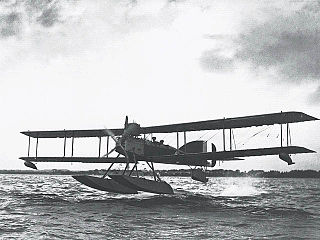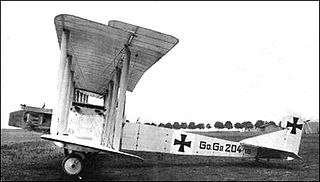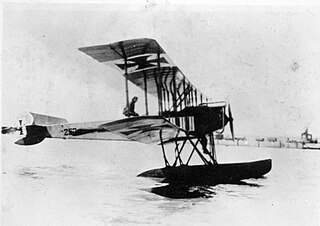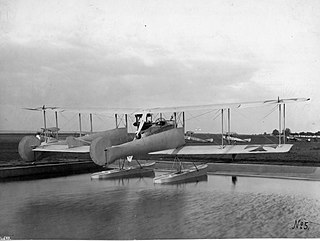
A torpedo bomber is a military aircraft designed primarily to attack ships with aerial torpedoes. Torpedo bombers came into existence just before the First World War almost as soon as aircraft were built that were capable of carrying the weight of a torpedo, and remained an important aircraft type until they were rendered obsolete by anti-ship missiles. They were an important element in many famous Second World War battles, notably the British attack at Taranto, the sinking of the German battleship Bismarck, the sinking of the British battleship HMS Prince Of Wales and the British battlecruiser HMS Repulse and the Japanese attack on Pearl Harbor.

The Fairey Swordfish is a biplane torpedo bomber, designed by the Fairey Aviation Company. Originating in the early 1930s, the Swordfish, nicknamed "Stringbag", was principally operated by the Fleet Air Arm of the Royal Navy. It was also used by the Royal Air Force (RAF), as well as several overseas operators, including the Royal Canadian Air Force (RCAF) and the Royal Netherlands Navy. It was initially operated primarily as a fleet attack aircraft. During its later years, the Swordfish was increasingly used as an anti-submarine and training platform. The type was in frontline service throughout the Second World War.

The Heinkel He 115 was a three-seat World War II Luftwaffe seaplane. It was used as a torpedo bomber and performed general seaplane duties, such as reconnaissance and minelaying. The aircraft was powered by two 960 PS BMW 132K nine-cylinder air-cooled radial engines. Some later models could seat four, had different engines or used different weapon arrangements.

The Courageous class, sometimes called the Glorious class, was the first multi-ship class of aircraft carriers to serve with the Royal Navy. The three ships—Furious, Courageous and Glorious—were originally laid down as Courageous-class battlecruisers as part of the Baltic Project during the First World War. While very fast, their minimal armour and few guns limited their long-term utility in the post-war Royal Navy, and they were laid up after the war. They were considered capital ships by the terms of the 1922 Washington Naval Treaty and were included in the total amount of tonnage allowed to the Royal Navy. Rather than scrap them, the Navy decided to convert them to aircraft carriers as permitted under the Treaty.
This is a list of aviation-related events from 1917.

The Gotha G.I was a bomber aircraft used by the Luftstreitkräfte during the First World War.

The Blackburn Shark was a carrier-borne torpedo bomber designed and built by the British aviation manufacturer Blackburn Aircraft. It was originally known as the Blackburn T.S.R., standing for "torpedo-spotter-reconnaissance", in reference to its intended roles. The Shark was the last of Blackburn's biplane torpedo bombers.

A submarine aircraft carrier is a submarine equipped with aircraft for observation or attack missions. These submarines saw their most extensive use during World War II, although their operational significance remained rather small. The most famous of them were the Japanese I-400-class submarines and the French submarine Surcouf, although small numbers of similar craft were built for other nations' navies as well.

The Short Admiralty Type 184, often called the Short 225 after the power rating of the engine first fitted, was a British two-seat reconnaissance, bombing and torpedo carrying folding-wing seaplane designed by Horace Short of Short Brothers. It was first flown in 1915 and remained in service until after the armistice in 1918. A Short 184 was the first aircraft to sink a ship using a torpedo, and another was the only British aircraft to take part in the Battle of Jutland.
A German air campaign of the First World War was carried out against Britain. After several attacks by seaplanes, the main campaign began in January 1915 with airships. Until the Armistice the Marine-Fliegerabteilung and Die Fliegertruppen des deutschen Kaiserreiches mounted over fifty bombing raids. The raids were generally referred to in Britain as Zeppelin raids but Schütte-Lanz airships were also used.

The Hansa-Brandenburg W.29 was a German two-seat fighter floatplane which served in the closing months of World War I with the Imperial German Navy's Naval Air Service from bases on the North Sea coast. In concept the aircraft was a monoplane version of the biplane Hansa-Brandenburg W.12, although there were many structural differences between the two.

The Gotha G.II series was a heavy bomber used by the Luftstreitkräfte during World War I.

The Gotha G.IV was a heavy bomber used by the Luftstreitkräfte during World War I. It was the first mass-produced relatively large airplane.

The Friedrichshafen FF.29 was an unarmed maritime reconnaissance floatplane built for the Imperial German Navy's Naval Air Service that was produced by Flugzeugbau Friedrichshafen during World War I. The aircraft entered service in November 1914, mostly conducting maritime patrols over the North Sea and the English Channel, and played a small role in the Raid on Cuxhaven the following month. A FF.29 became the first aircraft to be transported by a submarine when it was used in experiments in January 1915. In May an emergency landing by a FF.29 was the cause of the action off Noordhinder Bank when German forces were searching for the floatplane when they encountered a superior British force. The aircraft was also involved in developing methods of controlling artillery fire from the air.

The Friedrichshafen FF.35 was a German three-seat floatplane torpedo bomber built during World War I by Friedrichshafen Flugzeugbau built for the Imperial German Navy's Naval Air Service. Only one prototype was constructed in 1916 and it saw limited operational use during the war in Courland.

The Gotha WD.2 and its derivatives were a family of military reconnaissance aircraft produced in Germany just before and during the early part of World War I.

The Gotha WD.3 was a prototype maritime reconnaissance floatplane developed during World War I by Gothaer Waggonfabrik (Gotha) for the Imperial German Navy's Naval Air Service. The three-seat aircraft used the pusher configuration with the engine behind the crew. It was lacking in performance compared to aircraft with the more common tractor configuration with the engine in the nose and was not approved for production. The single prototype completed was used as a training aircraft; its ultimate fate is unknown.

The Gotha WD.7 was a twin-engine maritime patrol and torpedo-bomber training floatplane developed during World War I by Gothaer Waggonfabrik for the Imperial German Navy's Naval Air Service. The WD.8 was a single-engine version of the WD.7 developed for comparative purposes. The single aircraft built was deemed "totally unsuitable" by the Naval Air Service and was later sold to the Ottoman Empire.

The Gotha WD.14, WD.20, and WD.22 were a family of biplane torpedo bomber floatplanes developed in Germany during World War I.

The England Squadron, officially Kagohl 3 or later Bogohl 3, was a squadron of the Imperial German Army Air Service, formed in late 1916 during the First World War for the purpose of the strategic bombing of the United Kingdom and specifically London. The first air raid of the squadron on 25 May 1917 was unable to reach London, but bombed the coastal town of Folkestone instead. On 13 June, the squadron bombed London in daylight causing nearly 600 casualties. A further raid in July prompted reinforcement and reorganisation of the capital's air defences, but German losses had also caused a switch to bombing by night.




















